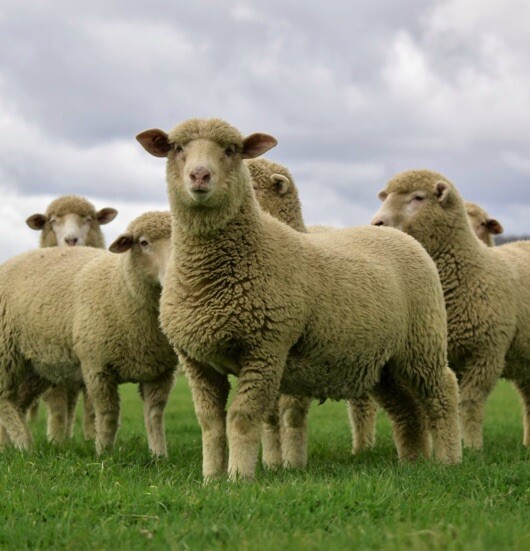Managing issues in sheep this spring
Hoof and other issues in sheep are popping up during spring 2022.

Key messages
- Monitor sheep for foot problems & try to move affected sheep to a dry area to allow feet to recover
- Look for signs of skin and insect borne diseases, dehydration and other illnesses
- Isolate newly arrived sheep to prevent the introduction of diseases or parasites
Continuing wet conditions mean that livestock will be particularly vulnerable to foot and skin conditions and diseases spread by insects in the coming weeks. Poor quality drinking water and feed could also affect animal health.
Hoof problems are especially likely where animals having been on wet/saturated ground for long periods. This can then lead to lameness and poor weight gain, poor joining, declines in wool quality and possibly even death (when heavily pregnant ewes are affected by recumbency or pregnancy toxaemia).
Hoof disease & wet weather
Scald
‘Scald’ (official name Ovine Interdigital Dermatitis - OID) is a mild infection of the skin between the hooves of sheep, which is usually found after continued exposure to wet pastures. The the skin is moist and painful, and sometimes a greyish/white fluid is present.
OID can cause sheep to become susceptible to other bacterial infections such as footrot and foot abscess, so it’s important to ensure hooves are given a chance to dry out. If logistics allow, keep affected sheep overnight on a hard dry floor, or on the grating of a shearing shed.
Foot bathing programs over Winter/Spring can also help.
Footrot
Footrot is a notifiable disease in Victoria and NSW, caused by Dichelobacter nodosus. The bacterium breaks down the tissue between the horn and the foot and can result in the painful separation of the sole.
There are a number of strains of footrot, each with a different ability to cause disease (benign strains have a poor ability to under-run the hoof horn and usually affect the skin between the toes, while virulent strains can rapidly under-run and separate the hoof horn from the foot).
The footrot bacterium is unable to infect a healthy foot and usually occurs after OID.
Footrot spreads/multiplies rapidly in warm, moist conditions, so is often most visible in spring. Farmers introducing new stock to their farms should be mindful of the continued potential for transmission and be prepared to isolate new stock.
Abscess
Heel and toe abscess are more common in fat, heavy sheep (especially twin bearing ewes), with abscesses more common in good seasons/high rainfall areas, when conditions are likely to favour development of OID. In these situations, sheep are often in fat condition and grazing high biomass pastures.
Heel abscesses are caused by bacteria normally found in the gut/faeces of healthy sheep. The bacteria only cause disease when the normally healthy skin of the foot is damaged (i.e. via OID), which allows the bacteria to enter and invade the deeper soft tissue of the foot, leading to abscess. Toe abscesses are caused when physical damage to the toe allows a variety of bacteria from the environment to enter.
To prevent hoof issues, try to avoid allowing livestock to become over-fat and avoid muddy yards, laneways and ground conditions (which may be extremely difficult at the moment).
Other issues to watch out for:
- Wet conditions will increase insect populations; monitor for flystrike and other diseases spread by flies (such as pinkeye)
- Skin diseases such as fleece rot and lumpy wool are more common in wet seasons and could increase flystrike
- Mould growth on standing or stored feed can reduce palatability and nutrient value (mould toxicity could also occur), and an alternative feed supply might be needed
- Drinking water quality (sheep may refuse to drink contaminated water and become dehydrated)
- Moist pasture increases the survival period of worm larvae and worm burdens could increase rapidly. Keep on top of worming programs (also watch out for Barber’s Pole Worm, which has increasingly been a problem in the Riverine Plains)
- Mastitis could also occur in ewes due to udder abrasions and muddy conditions
- Vaccinating with 5-in-1 after floods is important as the sudden flush of feed may make stock susceptible to pulpy kidney
- Bloat could also occur, especially on lush clover or lucerne
Establishing a stock containment area so that stock have access to shelter, clean water and feed, may also be beneficial.
For prevention and best treatments, contact your local veterinarian for advice.
Farmers who have been impacted by floods and require assistance or have urgent animal welfare needs, can contact the VicEmergency Hotline on 1800 226 226. In NSW, contact LLS on 1800 814 617.
Resources & further reading
Author
Sophie Hanna
Project Manager (Livestock) Bachelor of Agriculture and Bachelor of Science (Honours) Soil Sciences
20 October 2022
NEWS
Keep up to date with the latest news from across the Riverine Plains.
-
Livestock
-
People
-
Grains
-
Sustainability

